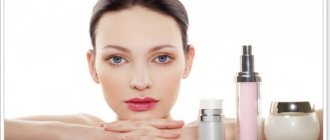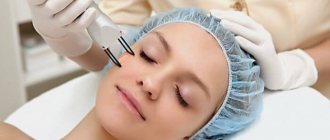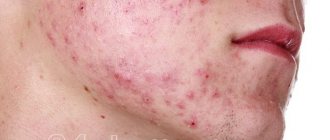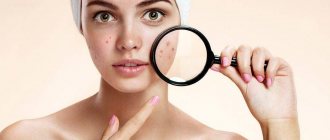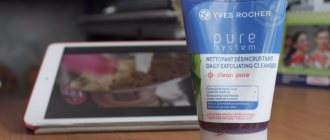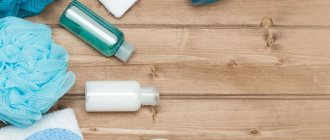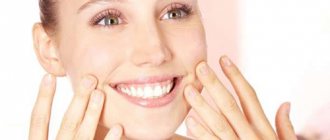Development mechanism
This skin problem occurs due to excessive activity of the sebaceous glands, clogging of their ducts with keratinized cells, which are immediately filled with subcutaneous fat. Such an environment is excellent conditions for the active reproduction of negative pathogenic agents, for example, staphylococcal or streptococcal in nature. Pyoderma is formed - inflammatory manifestations in the upper layers of the skin.
If inflammatory manifestations have not formed, characteristic dark-colored dots are visually visible on the dermis.
Reasons for development
According to dermatological specialists, the most significant reasons for the formation of acne on the face include:
- An increase in the amount of subcutaneous fat due to an uncorrected diet.
- The presence of hormonal “storms” in the human body.
- Neglect of basic personal hygiene procedures.
- Congenital anomalies in the structure of facial pores, the ducts are too narrow and are not able to cope with the load.
- Chronic stressful situations.
- Weakening the parameters of immune individual barriers.
- The presence of other somatic pathologies, for example, in the thyroid organ or nervous tissue.
- Taking hormonal drugs.
- Avitaminosis.
- Use of low-quality cosmetic products.
- External mechanical pressure on the skin, for example, tight hats.
These reasons can only provoke the occurrence of acne. In the absence of conditions favorable for the reproduction of negative agents, such a problem does not bother a person.
Features of the disease in adults
Medicines used to treat teenagers are often not suitable for treating facial acne in adults. The fight against acne in this case is complicated by the following circumstances:
- In adults, the skin cannot regenerate as quickly as in adolescents, and therefore traces of the disease in the form of scars are more noticeable, and the consequences of squeezed pimples are especially noticeable.
- In mature people, acne is more deeply rooted, so its inflammation is much stronger than in young people.
- Acne in adults most often appears on the chin and cheeks. If you believe Chinese medicine, then it is these zones that give an idea of the functioning of the endocrine glands. And in case of acne rash on the chin and cheeks, in addition to a dermatologist, you should also contact an endocrinologist so that he can carefully examine this phenomenon and establish the cause of its occurrence.
- The skin of a mature person is subject to drying out more often than the skin of a teenager, so the doctor, when choosing a therapeutic agent, takes this factor into account so as not to overdry the epidermis, which is why wrinkles appear on the face and the person looks old.
Forms of rashes
The formation of rashes on the skin of the face is not as painful as it is psychologically uncomfortable, because dark spots and inflamed elements, as a rule, do not make anyone look bad. Acne can form in a variety of forms - directly depending on the individual parameters of the human body, the root causes of their formation, as well as a person’s commitment to hygiene procedures.
- Blackheads are the result of incomplete blockage of the gland ducts. Part of the subcutaneous fat manages to reach the surface of the epidermis, where, under the direct influence of melanin, it acquires a dark color. Even in the absence of cosmetic procedures, such a problem can resolve itself - the remnants of accumulated fat will be removed on their own.
- Closed comedones are whiteheads. Caused by intradermal blockage of the sebaceous ducts, as well as their expansion. Visually they appear as lumpy subcutaneous formations with no exit of the duct to the outside. They can form in any age category, in people not only with oily skin, but also with those prone to dryness.
- Rosacea is caused by inflammatory manifestations in them that begin after blockage of the ducts. Papules are raised bumps above the skin level, colored pink or red. Upon palpation, a person notes moderate pain in them. In the absence of specialized help, the negative flora continues to multiply. A purulent focus forms inside the acne - pyoderma.
- Conglobate acne presents an ominous picture; these are lumpy accumulations of formations of different ages, with a red-bluish color and pustular inclusions. They are formed in the deepest elements of the dermis and are also caused by blockage of the sebaceous ducts.
Timely contact with a dermatologist in the first stages of the formation of pathology helps to prevent such severe forms of acne.
General information
Acne is a pathological manifestation of an inflammatory nature that develops on the skin of the face, back, and décolleté. They can look like comedones , that is, blackheads, and like pimples. This phenomenon is mainly characteristic of adolescence: about 80% of teenagers experience acne to one degree or another. However, this disease quite often affects adults: approximately 25% of men and 50% of women note the appearance of acne at some stage in their lives.
Treatment tactics
No matter how “elementary” the pathology may seem, the therapeutic tactics of getting rid of acne on the face is a very lengthy and difficult process. As a rule, it takes several weeks, or even months, even using the most modern, innovative developments in the field of dermatology.
How to treat acne in each case is decided by a specialist strictly individually. For the most complete and long-lasting relief from acne, it is necessary to prevent the occurrence of exacerbations and develop a special individual strategy for skin care after completion of treatment procedures.
Severe, advanced versions of acne are treated only under the strict supervision of specialists in beauty salons or medical institutions. In this case, self-medication can only cause irreparable harm.
Currently, comprehensive treatment tactics include:
- Medicinal compositions of hormonal nature.
- Antibiotic therapy.
- Retinoids.
- Medicines that help stop the hyperactivity of the sebaceous glands and help prevent stagnation in them.
- Antibactericidal drugs.
- Immunomodulators and immunostimulants.
- Antimycotics and hormonal drugs may be required.
- Vitamin therapy.
Traditional recipes, after their agreement with a specialist, only complement the basic complex treatment tactics. They can quite effectively speed up the recovery process, helping a person cope with the problem at home.
List of sources
- Adaskevich V.P. Acne vulgar and pink. M.: Medical book, N. Novgorod: NGMA Publishing House; 2003;
- Mayorova A.V., Shapovalov V.S., Akhtyamov S.N. Acne in the practice of a dermatocosmetologist. M.: “Firm Kavel”, 2005;
- Wolfe K., Johnson R., Surmond D. Dermatology according to Thomas Fitzpatrick. Atlas-directory. Second Russian edition. M.: Praktika 2007;
- Samtsov A.V. Acne and acneiform dermatoses. M., 2009.
- Adaskevich V.P. Diagnostic indices in dermatology. Moscow: Medical book; 2004;
General recommendations
It would seem that it is difficult to get rid of acne; just cleanse the skin and apply ointment. But serious complications can get in the way of such tactics; the human body begins to produce so much subcutaneous fat that the ducts are simply not able to cope with it.
Therefore, the first thing that needs to be done is to reduce the parameters of subcutaneous sebum production. Adjusting the individual diet plays a huge role:
- Eat only natural products, more fiber, cereals, herbs, vegetables, fruits.
- Completely avoid fatty and fried foods, carbonated drinks and preservatives.
- Avoid or limit: fatty foods, flour, as well as sweets and coffee, chocolate.
- Get rid of existing negative habits, for example, smoking, frequent consumption of alcohol.
In second place are individual hygiene procedures:
- Carefully select products for removing decorative cosmetics. If you are prone to acne, it is recommended not to purchase creams, ointments, or masks that contain lanolin or petroleum jelly as one of the components.
- Carry out washing every day - in the morning and also in the evening. Use special modern gels for washing, since the use of soap, especially toilet soap, noticeably dries out the epidermis. The dense stratum corneum further clogs the ducts of the sebaceous glands, aggravating the course of the pathology.
- Use only an individual, absolutely clean, towel for the face area; it should only be used by one person.
- Pillowcases should also be washed more often, especially during the hot season.
- Try not to touch your face during the day, especially with dirty fingers.
- At the initial stages of acne formation, try not to “squeeze” them, as the risk of infection and bacterial agents increases significantly. It is recommended to purchase a special preparation, which, after application, will help activate the regenerative abilities of the dermis. The pimple simply does not have time to form into an acne.
If you act according to a plan developed together with a dermatologist, following the above points, and also avoid chronic stressful situations, try to choose a place of residence away from polluting factors, then relapses of acne will become rare, and the facial skin will delight the owner with radiant beauty.
Diet, nutrition for acne
Diet for acne
- Efficacy: therapeutic effect after 21-30 days
- Terms: 6-8 months
- Cost of products: 1700-1800 rubles. in Week
Diet for clearing facial skin from acne
- Efficacy: therapeutic effect after 21 days
- Time frame: at least 6 months
- Cost of products: 1500-1600 rubles. in Week
For patients of any age who have developed acne, it is important to adjust their diet to ensure that their body eliminates toxins as efficiently as possible. Acne treatment will be much more effective if a person follows a gentle diet. Patients suffering from severe acne are recommended to include as many fresh fruits, vegetables, and nuts in their diet. The large amount of vitamins contained in such products have an excellent effect on the overall condition of the skin and help get rid of acne.
Foods that contain a lot of vitamin C : citrus fruits, strawberries, melons, cabbage, potatoes.
To strengthen the immune system, you need vitamin E , which is found in peanuts, almonds, and leafy vegetables. The functions of epithelial tissues are improved by vitamin A , which also prevents the formation of acne and wrinkles. It is found in large quantities in carrots, pumpkin, broccoli, melon, cabbage, spinach, and orange vegetables.
In addition to these foods, it is recommended to eat pumpkin seeds, legumes, and salad for acne.
At the same time, you should not abuse sugar, white rice, or white flour products. Eating such foods leads to excess insulin in the blood, which contributes to hormonal fluctuations and deterioration of the skin. There is also an opinion that the problem of acne is aggravated by the consumption of dairy products. You should also not drink coffee and especially alcoholic beverages frequently. But you need to drink a lot of water - at least seven glasses a day. After all, a lack of moisture contributes to dry skin, and the healing and renewal process of the skin slows down.
Simple procedures
There are many proven recipes for quickly getting rid of acne in its early stages. For example, rubbing the face with ice cubes prepared from decoctions of medicinal herbs such as chamomile, celandine, calendula, string, aloe juice.
Tea tree and eucalyptus oils also have a pronounced antibacterial effect. It is enough to add a few drops of the product to a decoction for washing or lotion.
Traditional remedies that are necessarily included in treatment tactics include: Zenerit and Baziron. They have antibacterial power, successfully suppressing the proliferation of negative agents on the dermis. There are also a variety of other medications that contain: sulfur, salicylic acid, zinc or silver - they are used after washing to successfully combat pyoderma and acne.
Such products have a side effect - dry skin, but this condition is completely corrected with modern moisturizing creams. If acne recurs more than 4-5 times a year, you should definitely seek advice from a dermatological specialist to determine the root cause.
Diagnosis of late acne
As soon as a patient suffering from late acne contacts a dermatologist, the specialist will immediately send him to collect anamnestic data in order to determine the cause of late acne. In this case, this type of rash will be examined and further research, which is often dermatoscopy. Diagnostics also includes research through bacterial culture. If necessary, a consultation with a gastroenterologist or even an endocrinologist can be carried out. In addition, a stool test is ordered. Women suffering from late acne should also consult a gynecologist and examine the level of testosterone in the blood, conduct an ultrasound of the uterus and ovaries.
Cosmetic recommendations
The first aid to acne-strewn skin is to release clogged pores from the yoke of accumulated subcutaneous fat. For this purpose, a variety of exfoliating agents are used, for example, scrubs with solid particles or gel scrubs. Experts recommend using them no more than 1-2 times a week, with great caution - significant mechanical impact can lead to additional skin irritation.
Today, the product line of many well-known brands includes scrubs based on fruit acids with a milder exfoliating effect, suitable for almost all skin types.
Exfoliating masks can have a similar effect; they very effectively help get rid of the keratinized layers of the dermis. Use them 1-2 times a week.
The gentle effects of steam - a kind of “bath” for the face - have also proven themselves excellent since the times of our grandmothers. A handful of medicinal plants, for example, lemon balm or mint, are added to boiling water, and after such a cosmetic procedure, the skin is treated with a drying agent.
Acne in women
Women also have ugly acne, but this is much less common than in men. A woman may suffer from acne due to a weakened immune system, psychological stress, poor diet, hormonal imbalances and bad habits. And also other reasons:
- polycystic ovary syndrome;
- pregnancy (retinoids are contraindicated);
- depression;
- diseases of the gastrointestinal tract;
- hormonal imbalance after abortion;
- Acne often occurs during the premenstrual window and in the last phase of the menstrual cycle.
